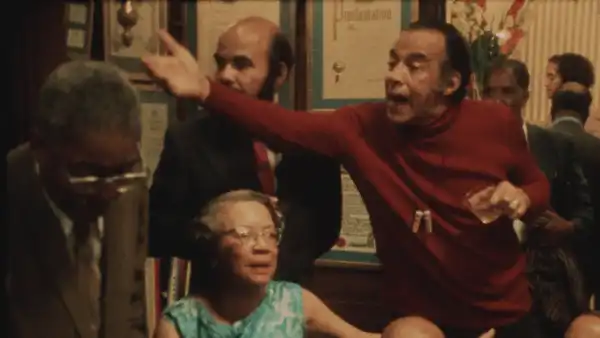
Save this storySave this storySave this storySave this story
A principal misdeed of established Hollywood was its massive dedication to make-believe and its near neglect of reality-based storytelling, which, originally, was mostly restricted to “newsreels.” Consequently, much of the dialogue in sound pictures was slick banter written by screenwriters; it fell to independent directors to build up innovative nonfiction as a structure for authentic conversations. Achieving this became a key aim of contemporary cinema, evident in epochal works like “Chronicle of a Summer,” “Portrait of Jason,” “Shoah,” and the comprehensive filmography of Frederick Wiseman. Add another to the list, because I have recently seen one of the most outstanding sound films, one of the most impressive cinematic pieces of imaginative nonfiction, that I have ever encountered: “Once Upon a Time in Harlem,” a spoken account of the Harlem Renaissance which the director William Greaves filmed back in 1972. Regretfully, I must note that, for the present, it isn’t possible for the movie to be shown broadly.
This is due to the fact that the film is still in progress. It is now a preliminary version lasting ninety-eight minutes; its finalization depends on ongoing financial support. Segments of the evolving work have been presented publicly at the Metropolitan Museum of Art and moma. I was able to view the draft at a special preview a short while ago, and I am convinced that, had Greaves been able to finalize the project shortly after filming the material, it would have dramatically altered history, and for the better. This picture would have highlighted the Harlem Renaissance and its leading figures to a far greater degree, during a period that often overlooked that movement’s icons—as well as emerging Black artists, a reality that Greaves himself knew firsthand. Despite a respected career as a maker of documentaries, Greaves experienced apathy and rejection concerning his more ambitious endeavors. His crowning achievement, “Symbiopsychotaxiplasm: Take One,” is an extraordinary blend, a fictional narrative cleverly woven into the actual conditions of its production. Filmed in 1968 and completed in 1971, it was turned down by the Cannes Film Festival and never received distribution. It wasn’t until 1991, at a screening at the Brooklyn Museum, that the immensity of its accomplishment began to be acknowledged.
In “Once Upon a Time in Harlem,” Greaves puts into practice a strategy for nonfiction that is likewise creative and electrifying, yet nonetheless direct in its presentation of data. He captured a sequence of discussions with several prominent Harlem Renaissance figures and then organized—and documented—a gathering for a wider circle of contributors at Duke Ellington’s Harlem home. The footage was initially recorded for a movie about the Harlem Renaissance named “From These Roots,” which Greaves did complete, in 1974, but almost totally using archival photographs. The discussions and interviews were shelved, as Greaves considered what to do with them. He revisited the footage over the years, eventually starting work on it toward the end of his life, until his failing health prevented him. Greaves passed away in 2014, at eighty-seven, with the film uncompleted but sure that the footage he had filmed was his most vital creation. His widow, Louise Archambault Greaves, pursued the task until her own passing, in 2023, at ninety; now Greaves’s son David (one of the project’s camera operators) and David’s daughter Liani, are making headway with it. (David is credited as the director of the cut I observed, and Liani is a co-producer, alongside Anne de Mare.)
The film’s structure, which can be discerned even in an unfinished form, is as naturally elegant as its topic is urgent and its conversations are impassioned. The gathering (which lasted roughly four hours) gives order to the final product, providing a straightforward foundation with ample opportunity for inserting further discussions, archival clips, and images. The film’s intellectual concept—loyal to Greaves’s modernist spirit—originates from the pragmatic essence of its production, specifically, a joining of festivity and intellectualism, shared aims and dialectical clashes. The tenor of the dialogue presented is suitable both to its intimate atmosphere and its societal significance. It consists of discussions among acquaintances, yet friends who are noticeably cognizant that this meeting is creating history in tandem with honoring it. Emotions run as deeply as flair, and sincerity and ardor coalesce with humor, bestowing recollections and insights with pride and resolve, as well as sorrow and resentment. When commenting on “Once Upon a Time in Harlem,” I am tempted to simply quote as extensively as I can recall, since the dialogue is magnificent—evocative reminiscences, dazzling cleverness, bright eloquence, profound thoughts, melancholic assessments, the creative potency of literary craft soaring—all within an environment of hard-earned fellowship.
The attendees encompass a number of significant creative figures, such as the ragtime musician Eubie Blake; the artists Romare Bearden and Aaron Douglas; the photographer James Van Der Zee; the poet and novelist Arna Bontemps; the writer, painter, and dancer Richard Bruce Nugent; and the editor and society-page columnist Gerri Major. Other people played critical but less visible roles in the movement: the librarians Regina Andrews and Jean Blackwell Hutson; the actor-managers Leigh Whipper and Irvin C. Miller, and the playwright-producer Abram Hill; the scholars John Henrik Clarke and Nathan Huggins; and Ida Mae Cullen, Countee Cullen’s widow. Some of those present hadn’t been together for fifty years. The majority were aging, some exceptionally so (Whipper was ninety-six); and a number of the key creators at the core of the narrative had died—some long before, others, such as Langston Hughes, only a handful of years prior.
The Harlem Renaissance—the theme for which everyone had convened to examine—is characterized in the film by Major as the initial instance of Black people being appreciated as imaginative people; by another participant, as validating the greatness of Black individuals; by Bontemps as “a prism” mirroring Black lives through the ages; and by George Schuyler as not a renaissance at all but an “awakening.” Personal thoughts frequently center on individual experiences that clarify subjects of expansive historical and political importance, reaching well beyond particular creations of art. Blake refutes a common assertion that he would never shake a white man’s hand, explaining that he merely never extended his own hand first, to prevent the man from having a chance to slight him. Whipper recounts when the great dancer Bill (Bojangles) Robinson was snubbed precisely in this manner by Charles Lindbergh, only for Jimmy Walker, then the mayor of New York, to rescue the situation by rapidly clasping Robinson’s offered hand himself. Whipper also speaks about his friendship with the poet and novelist Paul Laurence Dunbar, who died in 1906, at the age of thirty-three; the pair had been neighbors and fishing partners. Blake recalls the compelling stage presence of the tragically short-lived actress Florence Mills. The artist Ernest Crichlow evokes the memory of the sculptor Augusta Savage, whose studio, in a Harlem basement—among furnaces and piles of coal—was a haven of learning and a center of ingenuity.
That studio is among numerous sites, both formal and informal, identified across the movie as gathering places where artists, activists, journalists, and other distinguished figures socialized, and where an array of endeavors were promoted, supported, funded, and broadcast to public view. Publications like The Crisis, Opportunity, and The Messenger are cited as locations where poets like Langston Hughes and Cullen were published, and where Douglas was hired to create covers. Black writers also secured roles at a range of Black-owned newspapers, including the Amsterdam News. (Finances were key, whether acquired through work or through backing by the entrepreneur A’Lelia Walker or the “gangster philanthropist” Casper Holstein.) The 135th Street location of the New York Public Library—where Andrews was the city’s inaugural Black principal librarian—was a hub for writers, the unofficial daily workspace for Cullen, Claude McKay, and others. Andrews’s apartment, at 580 Saint Nicholas Avenue, functioned as a type of salon for writers and artists, and Major’s position as a society-page columnist made her social events a crucial core of the Black elite.
Bontemps, who, beyond his literary work, served as a librarian and educator, provides insightful historical context, stating that the Harlem Renaissance began with three occurrences: Marcus Garvey’s initial convention in Harlem, in August, 1920; the staging of the musical “Shuffle Along,” featuring music by Blake and lyrics by Noble Sissle, in May, 1921; and, in June of that year, the initial release of a poem by Langston Hughes (“The Negro Speaks of Rivers,” featured in The Crisis). This convergence of literature, politics, theatre, and music, compacted within a single year the immense scope of the Harlem Renaissance, its wellsprings, and its reverberations.
Those present openly explore the bigotry of those formative times, encompassing the commonality of lynchings and the slaughters of Black individuals in Tulsa, in East St. Louis, and in Elaine, Arkansas. They bring back to mind the community’s reactions to atrocities, including the Silent Parade of 1917, in which thousands marched along Fifth Avenue. There are memories of the vexing normality of racial insults and exclusions, the daring plan to integrate the Copacabana, and the unremedied injustices experienced by earlier generations; Whipper tells of the Ku Klux Klan’s threats to his father, a lawyer and state legislator in South Carolina, following Reconstruction.
For all the collective sense of intent, there was likewise disagreement within the Harlem Renaissance. During the documented discussions, attendees acknowledge that the Harlem Renaissance wasn’t a unified movement but contained “many intellectual centers” and functioned more as a “forum.” Richard Moore, a writer and activist, questioned Garvey’s belief in the separation of the races and the dominance of Black Americans in African affairs. In 1926, Schuyler released his piece “The Negro-Art Hokum” in The Nation; the following week, the magazine issued Hughes’s strong reply, “The Negro Artist and the Racial Mountain.”
This dialectic was part of a thriving sphere of superb language. The Harlem Renaissance overflowed with poetry and song—and with performance, as memorialized in Greaves’s footage which captures numerous unscripted, profoundly theatrical renditions of poems by Bontemps, Hughes, Cullen, and McKay. Sissle vocalizes one of his songs in the picture, and there’s even a speech from a Hollywood film (“Mission to Moscow,” from 1943) in which Whipper had embodied Haile Selassie; in the presence of friends, three decades later, he speaks the lines from his memory. Likewise, the scores of people whom Greaves interviews in the movie aren’t delivering a singular and unanimous account of the Harlem Renaissance but a multifaceted relay of it. Recounting their personal stories, attesting to pivotal eras, and reflecting on their deeds and observations, they propose not a historical overview but a present-day re-embodiment, a revival of a renaissance.
Greaves, born in Harlem in 1926 and brought up there, was himself a descendant of the Harlem Renaissance, immersed in its cultural currents. By investigating the movement, Greaves (as the film itself demonstrates) was investigating himself. Perhaps this explains why, while he had little difficulty finalizing the distant, encyclopedia-like documentary “From These Roots”, he struggled with the interview and discussion footage. He was wrestling both with history and his own existence. The Greaves family hopes to premiere the film in celebration of his centennial, in October, 2026. “Once Upon a Time in Harlem,” upon its completion and widespread exhibition, will take its place as a crucial record of history, and as the film of a lifetime. ♦
Sourse: newyorker.com






